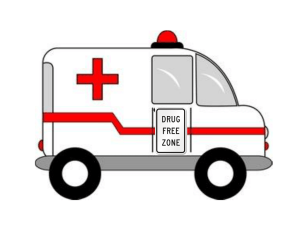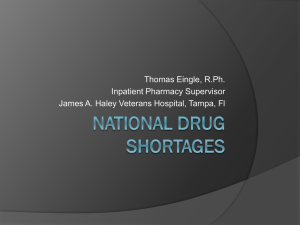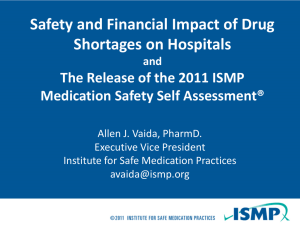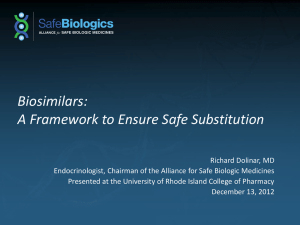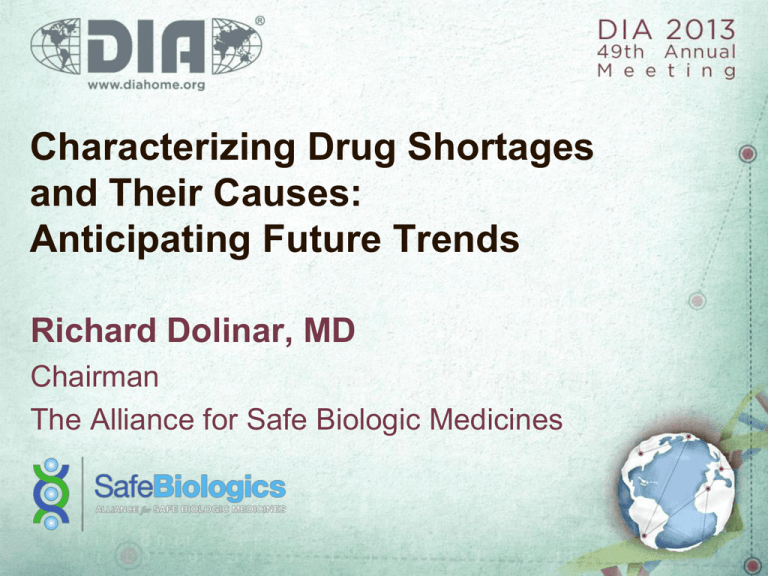
Characterizing Drug Shortages
and Their Causes:
Anticipating Future Trends
Richard Dolinar, MD
Chairman
The Alliance for Safe Biologic Medicines
Disclaimer
• The views and opinions expressed in the following PowerPoint
slides are those of the individual presenter and should not be
attributed to Drug Information Association, Inc. (“DIA”), its
directors, officers, employees, volunteers, members, chapters,
councils, Communities (formerly known as SIACs) or affiliates, or
any organization with which the presenter is employed or
affiliated.
• These PowerPoint slides are the intellectual property of the
individual presenter and are protected under the copyright laws
of the United States of America and other countries. Used by
permission. All rights reserved. Drug Information Association,
Drug Information Association Inc., DIA and DIA logo are
registered trademarks. All other trademarks are the property of
their respective owners.
2
Impact of Drug Shortages
According to the 2011 American Hospital Association’s Survey
on Drug Shortages, of 820 hospitals surveyed :
Quality of Care:
82% of respondents reported delays in treatments
69% said patients received less effective drugs
35% reported adverse outcomes
Access: 78% reported rationing or restricting drugs
Cost: 92% reported increased drug costs due to shortages
3
How Shortages Affect Patients
A University of Pennsylvania survey of 245
oncologists surveyed between March 2012 and
March 2013 found:
• 83% of oncologists had experienced drug
shortages—including potentially life-saving
drugs for breast, prostate, and ovarian
cancers—in the past six months.
• 79% of oncologists treated patients with
another drug or regimen
• 43% delayed a patient's treatment
• 37% had to choose which patients would receive treatments and which would wait
• 29% had to ask patients to skip doses.
4
Where Are Shortages Occurring?
80% of shortages
occurred among
Sterile Injectables:
• 28% oncology drugs
• 13% antibiotics
• 11% Electrolyte/nutrition
drugs
• 9% neuromodulators
• 6% hormonal
Source: A Review of FDA’s Approach to Medical Product Shortages, FDA Oct. 2011
5
Why Are Shortages Occurring?
One factor: the complex
manufacturing process.
The Manufacturing process must be
sterile, free of particulate matter, and
often requires dedicated production lines.
• 43% of shortages are due to
problems in manufacturing
process.
• 15% of shortages are due to
delays in manufacturing and/or
shipping.
Source: A Review of FDA’s Approach to Medical Product Shortages, FDA Oct. 2011
6
Why Are Shortages Occurring?
Another factor: market forces
•
Market concentration: few manufacturers of a given product lead to supply chain
vulnerability. (342 out of 569 (60%) sterile injectable molecules in 2010 were virtually
sole‐sourced), even among products with generic competitors.1
•
Wholesaler and GPO purchasers often put additional downward pressure on prices.2
When downward price pressure makes the margins too thin, manufacturers respond
to GMP violations by terminating production, which leads to shortages because the
low margin has pushed back-up producers out of the market.1
•
The top three generic injectable manufacturers hold 71% market share of sterile
injectables3, consequently, there are few, if any, suppliers to step in if one
manufactures has a problem that will create a shortage.
1 A Review of FDA’s Approach to Medical Product Shortages, FDA Oct. 2011
2 General Purchasing Organizations aggregate the purchasing volume of its members, typically provide contracted
discounts on medical supplies, nutrition, pharmacy and laboratory.
3 IMS Health, IMS National Sales Perspectives?™, Extracted September 2011. Based on 569 sterile injectable molecules.
7
FDA Approach to Reducing Shortages
FDA prevented 195 shortages in 2011 and almost 100 shortages during the first
half of 2012.1 Several key FDA authorities facilitated this:
• Expediting review of manufacturing sites
• Identifying other suppliers that could increase production to fill gap
• Working with manufacturers to identify and mitigate quality issues in
production (such as filtration of contaminants) to prevent shortages.
July 2012: Food and Drug Administration Safety and Innovation Act
(FDASIA) signed into law:
• Requires all manufacturers of covered drugs to notify FDA of potential
discontinuances, temporary or permanent. (The prior law applied only to sole
manufacturers.)
• Expands notification requirement to biologic products, which were previously
exempt.
1
http://www.fda.gov/RegulatoryInformation/Legislation/FederalFoodDrugandCosmeticActFDCAct/SignificantAmendmentstot
heFDCAct/FDASIA/ucm313121.htm Accessed June 2013
8
Medical Concerns Regarding Potential
Biologic Shortages
• No two biologic medicines are identical and patients may
respond to the differences.
• Switching a patient between biological products – whether
biosimilar or simply biologics in the same class – could
have unwanted and unintended consequences, including
an unwanted immune response.
• Therefore, biologic drug shortages could create additional
risk for patients.
9
What Makes Biologics a Drug Shortage Risk?
• Biologic medicines are generally sterile injectables, the drug
class historically most prone to shortages.
• The manufacturing process of biologic therapies is far more
complex than that of small-molecule drugs, including sterile
injectables.
• The proteins used in biologics are often highly sensitive to light,
heat, turbulence and container closure systems, among other
things.
• Shortages occur frequently among those who manufacture
copies; the first biosimilars are expected to be approved in
2013 – 2014, when the factors that lead to traditional drug
shortages may come into force soon.
10
Pharmacovigilance: Naming
Thailand has a substantial spike in Pure Red
Cell Aplasia, > 30 RBC stimulating products.
Which is the culprit?
Unique non-proprietary names are essential to distinguish these medicines
from one another, to track and trace adverse effects.
• Patient response must be traced to the correct manufacturer’s product.
• Unique naming provides transparency and helps differentiate products
for observing and reporting adverse events.
11
ASBM/FDLI Whitepaper, Nov. 2012
1. All biologics should receive distinct nonproprietary names.
2. United States Pharmacopeia (USP) should work
with FDA to adapt the product monograph system to
accommodate the unique attributes of structurallyrelated, but distinct, biologic medicines.
3. The non-proprietary name of a reference product
and product/s biosimilar to it should have a
common, shared root but have distinct and
differentiating suffixes.
4. Products designated interchangeable should have a
distinct name from the reference product for which
they are considered interchangeable to facilitate
accurate attribution of adverse events.
12
Medicine Naming Conventions
The same drugs…
should have the same
non-proprietary name.
Levothyroxine / levothyroxine
Synthroid® / Levothroid®
Similar drugs...
should have similar
non-proprietary names.
pravastatin / fluvastatin
Pravachol® / Lescol®
Different drugs…
should have different
non-proprietary names.
aspirin / acetaminophen
Bayer® / Tylenol®
13
Distinguishing Prefixes in Biosimilar Naming
FDA, 2012: “The nonproprietary name tbo-filgrastim is intended to differentiate
this product from Neupogen to minimize medication errors and facilitate
postmarket safety monitoring.”
ZALTRAP® (ziv-aflibercept),was also approved by FDA in 2012 using a
distinguishing prefix to differentiate from its reference biologic (aflibercept).
However, confusion between similar biologic medicines may still occur:
•
For example, the new medicine KADCYLA® (ado-trastuzumab) is dosed
differently than the reference biologic HERCEPTIN® (trastuzumab).
•
Cases have occurred wherein a prescribing physician has mistakenly
omitted the distinguishing prefix, resulting in a patient receiving the wrong
medication, at the wrong dose. (Confusion could also occur with suffixes).
•
Prefixes, unlike suffixes, prevent similar medicines from appearing together
in alphabetized lists, but potentially may allow the similarity to be missed.
14
Global Standards Being Discussed
However, FDA’s use of distinguishing prefixes does
not align globally.
On April 15-17, WHO held the 56th Consultation on
International Nonproprietary Names (INN) for
Pharmaceutical Substances.
ASBM Letter to WHO:
“Product naming is an important element of biologic
safety. We firmly advocate that all biologics should
receive distinct non-proprietary names to ensure
products will be distinctly identified to facilitate accurate
attribution of adverse events.
The non-proprietary name of a reference product and
product/s biosimilar to it, should have a common, shared
root but have distinct and differentiating suffixes as a
means of facilitating clear adverse event reporting.”
15
Pharmacovigilance: Testing
Clinical testing of a biosimilar medicine is vital for
gaining real-world data on how these medicines
actually function in a therapeutic setting.
Pre-approval and post-market clinical studies
should be required to demonstrate:
• Similar therapeutic response profile- that is, the
biosimilar is as safe and effective as the original
medicine
• Similar known side effects, not new ones
• Study should be long enough and large enough
sample size
16
Pharmacovigilance: Labeling
Clarity during prescription,
dispensing, and monitoring is
essential.
Biosimilars should be clearly labeled
with distiguishable product name,
name of the manufacturer, and the
product lot number to enable
physicians, pharmacists, and patients
to quickly identify the source of any
adverse effects.
This provides multiple means of
product identification (unique names,
NDC, lot numbers) avoid a single
point of information failure.
17
Summary: Ensuring Access to Safe Biologics
• Hold manufacturers accountable for the quality of their products.
• Transparency = Accountability.
– FDA can facilitate accountability by making information about
companies’ history of manufacturing quality [available to
purchasers, physicians, consumers / publicly available].
– Implementation of unique naming, and a robust track/trace
system including clear labeling will facilitate accurate
identification of biologic manufacturers.
• Rigorous testing of biosimilars – hold copies to the same
standard of quality as the reference biologics
18
Questions?
19


